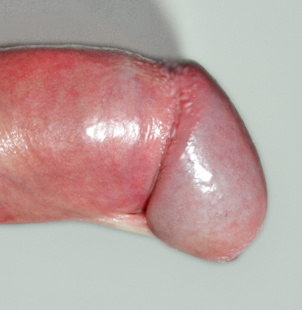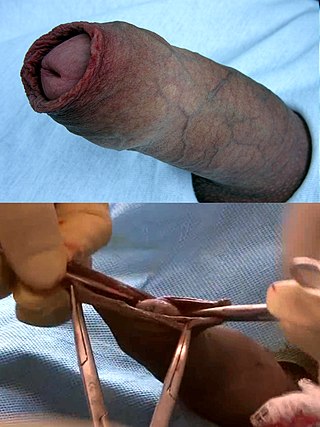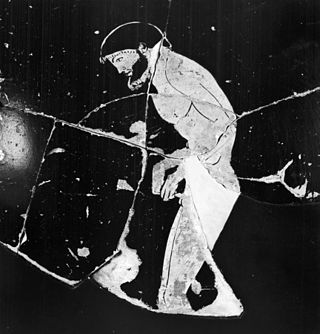
A restoration device is a device used for applying tension to skin during the process of non-surgical foreskin restoration. [1] Those who use such a device employ the use of tissue expansion, which causes new skin to grow.

A restoration device is a device used for applying tension to skin during the process of non-surgical foreskin restoration. [1] Those who use such a device employ the use of tissue expansion, which causes new skin to grow.
Until the 2nd century CE, the Pondus Judaeus was used among some circumcised males. It was a replacement for more painful techniques known at the time. This device was a bronze sheath used to expand the foreskin, which at the time was not fully excised. Its effectiveness became limited after circumcisions were modified to eliminate its use (Tushmet 1965). [2]
During the late 20th century and early 21st century, new techniques were developed to suit the needs of men circumcised by physicians in North America. These circumcisions often left little movable skin on the penile shaft, and this was taken into consideration by developers of restoration techniques. Some devices have been designed to require little skin to be usable. During the 1990s, the process of foreskin restoration employed adhesive tape, such as tapes used in hospitals or for athletics, to pull skin forward or attach weights and pulling devices to provide tension. [1]

The following steps describe the application of a typical tapeless device: [3]
The following steps describe the application of a typical device in which tape is needed: [4]
Older methods have been partially replaced by the use of various plastic or silicone components. The entire design and function of the “modern” devices was first described in the 2003 Foreskin Restoration Device patent [5] by the inventor of the Tug Ahoy. Many new devices grip the skin, usually without the use of tape. Some devices are homemade, often designed by men whose skin is easily irritated by adhesive tapes. There are several different varieties of tapeless restoration devices commercially available. Some silicone devices have an opening for a one-way air valve and a hand pump for inflating the foreskin. This expands the foreskin from within, creating skin tension and growth.

Most devices are equipped with an elastic band or some type of tension adjustment to pull the skin away from the glans. As the tension is applied, the natural process of mitosis is stimulated.
Some restoration devices are more comfortable or more effective than others. In some cases where there is too little skin to pull onto the gripping surface, pressure must be applied to the glans when applying the device. Most devices and weights are easily washed and can be reused each day.
The function of a foreskin retainer is to keep the glans penis covered by the available foreskin. A foreskin retainer can be used when newly grown foreskin is neither long enough nor tight enough to keep the glans covered itself, but is long enough that it can be stretched past the glans (which is necessary to facilitate the use of a retainer). Rubber bands, o-rings, Band-Aids, and cones with both ends open can be used as retainers.
The foreskin can also be retained with a medical adhesive, known as MRS. MRS is a silicone based skin safe adhesive. MRS originally stood for Miracle Restoration Spray, but is now available in a brushable form. A small amount of adhesive is applied to the glans, and the skin is rolled up and retained by the MRS. MRS sets up almost instantly, but the skin can still be pulled back if necessary.

The brit milah or bris is the ceremony of circumcision in Judaism and Samaritanism. According to the Book of Genesis, God commanded the biblical patriarch Abraham to be circumcised, an act to be followed by his male descendants on the eighth day of life, symbolizing the covenant between God and the Jewish people. Today, it is generally performed by a mohel on the eighth day after the infant's birth and is followed by a celebratory meal known as seudat mitzvah.

In male human anatomy, the glans penis or penile glans, commonly referred to as the glans, is the bulbous structure at the distal end of the human penis that is the human male's most sensitive erogenous zone and primary anatomical source of sexual pleasure. The glans penis is present in the male reproductive organs of humans and most other mammals where it may appear smooth, spiny, elongated or divided. It is externally lined with mucosal tissue, which creates a smooth texture and glossy appearance. In humans, the glans is located over the distal ends of the corpora cavernosa and is a continuation of the corpus spongiosum of the penis. At the summit appears the urinary meatus and at the base forms the corona glandis. An elastic band of tissue, known as the frenulum, runs on its ventral surface. In men who are not circumcised, it is completely or partially covered by a fold of skin called the foreskin. In adults, the foreskin can generally be retracted over and past the glans manually or sometimes automatically during an erection.

Foreskin restoration is the process of expanding the skin on the penis to reconstruct an organ similar to the foreskin, which has been removed by circumcision or injury. Foreskin restoration is primarily accomplished by stretching the residual skin of the penis, but surgical methods also exist. Restoration creates a facsimile of the foreskin, but specialized tissues removed during circumcision cannot be reclaimed. Actual regeneration of the foreskin is experimental at this time. Some forms of restoration involve only partial regeneration in instances of a high-cut wherein the circumcisee feels that the circumciser removed too much skin and that there is not enough skin for erections to be comfortable.

Genital modifications are forms of body modifications applied to the human sexual organs, such as piercings, circumcision, or labiaplasty. The term genital mutilation is generally used for genital modifications that diminish the recipient's quality of life and result in adverse health outcomes, whether physical or mental.
Infibulation is the ritual removal of the vulva and its suturing, a practice found mainly in northeastern Africa, particularly in Djibouti, Eritrea, Ethiopia, Somalia, and Sudan. The World Health Organization refers to the procedure as Type III female genital mutilation.

In female humans and other mammals, the clitoral hood is a fold of skin that surrounds and protects the glans of the clitoris; it also covers the external clitoral shaft, develops as part of the labia minora and is homologous with the foreskin in the male reproductive system. The clitoral hood is composed of mucocutaneous tissues; these tissues are between the mucous membrane and the skin, and they may have immunological importance because they may be a point of entry of mucosal vaccines.

Paraphimosis is an uncommon medical condition in which the foreskin of a penis becomes trapped behind the glans penis, and cannot be reduced. If this condition persists for several hours or there is any sign of a lack of blood flow, paraphimosis should be treated as a medical emergency, as it can result in gangrene.

Phimosis is a condition in which the foreskin of the penis cannot stretch to allow it to be pulled back past the glans. A balloon-like swelling under the foreskin may occur with urination. In teenagers and adults, it may result in pain during an erection, but is otherwise not painful. Those affected are at greater risk of inflammation of the glans, known as balanitis, and other complications.

Balanitis is inflammation of the glans penis. When the foreskin is also affected, the proper term is balanoposthitis. Balanitis on boys still in diapers must be distinguished from redness caused by ammoniacal dermatitis. The word balanitis is from the Greek βάλανοςbalanos, literally meaning 'acorn', used because of the similarity in shape to the glans penis.

A dydoe is a type of male genital piercing that passes through the ridge of the glans on the head of the penis. They are often done in pairs. Less often, a "king's crown" is where several dydoes are placed around the head of the penis. The jewelry is usually a 12 gauge, straight barbell with a ball on either end, although a ring may be used at a higher chance of rejection. A deep dydoe is one that uses a longer barbell and exits near the tip of the penis.

Frenulum breve, or short frenulum, is a condition in which the frenulum of the penis, which is an elastic band of tissue under the glans penis that connects to the foreskin and helps contract it over the glans, is too short and thus restricts the movement of the foreskin. The frenulum should normally be sufficiently long and supple to allow for the full retraction of the foreskin so that it lies smoothly back on the shaft of the erect penis.
Circumcision likely has ancient roots among several ethnic groups in sub-equatorial Africa, Egypt, and Arabia, though the specific form and extent of circumcision has varied. Ritual male circumcision is known to have been practiced by South Sea Islanders, Aboriginal peoples of Australia, Sumatrans, Incas, Aztecs, Mayans and Ancient Egyptians. Today it is still practiced by Jews, Muslims, Coptic Christians, Ethiopian Orthodox, Eritrean Orthodox, Druze, Samaritans and some tribes in East and Southern Africa, as well as in the United States, South Korea and Philippines.

Aposthia is a rare congenital condition in humans, in which the foreskin of the penis is missing.

A kynodesmē was a cord or string or sometimes a leather strip that was worn primarily by athletes in Ancient Greece and Etruria to prevent the exposure of the glans penis in public and to restrict untethered movement of the penis during sporting competition. It was tied tightly around the akroposthion, the most distal, tubular portion of the foreskin that extends beyond the glans. As depicted in Ancient Greek art the kynodesme was worn by some athletes, actors, poets, symposiasts and komasts. It was worn temporarily while in public and could be taken off and put back on at will. The remaining length of cord could either be attached to a waist band to pull the penis upward and expose the scrotum, or tied around the base of the penis and scrotum so that the penis appeared to curl upwards.

The frenulum of the penis, often known simply as the frenulum or frenum, is a thin elastic strip of tissue on the underside of the glans and the neck of the human penis. In men who are not circumcised, it also connects the foreskin to the glans and the ventral mucosa. In adults, the frenulum is typically supple enough to allow manual movement of the foreskin over the glans and help retract the foreskin during erection. In flaccid state, it tightens to narrow the foreskin opening.

In human anatomy, the penis is an external male sex organ that additionally serves as the urinary duct. The main parts are the root, body, the epithelium of the penis including the shaft skin, and the foreskin covering the glans. The body of the penis is made up of three columns of tissue: two corpora cavernosa on the dorsal side and corpus spongiosum between them on the ventral side. The urethra passes through the prostate gland, where it is joined by the ejaculatory duct, and then through the penis. The urethra goes across the corpus spongiosum and ends at the tip of the glans as the opening, the urinary meatus. It is a passage both for excretion of urine and the ejaculation of semen.

A dorsal slit is a single incision along the upper length of the foreskin from the tip to the corona, exposing the glans without removing any tissue. An ancient practice, it has been a traditional custom among a number of peoples, particularly Filipinos and Pacific Islanders, probably for thousands of years.

In male human anatomy, the foreskin, also known as the prepuce, is the double-layered fold of skin, mucosal and muscular tissue at the distal end of the human penis that covers the glans and the urinary meatus. The foreskin is attached to the glans by an elastic band of tissue, known as the frenulum. The outer skin of the foreskin meets with the inner preputial mucosa at the area of the mucocutaneous junction. The foreskin is mobile, fairly stretchable and sustains the glans in a moist environment. Except for humans, a similar structure known as a penile sheath appears in the male sexual organs of all primates and the vast majority of mammals.

Circumcision surgical procedure in males involves either a conventional "cut and stitch" surgical procedure or use of a circumcision instrument or device. In the newborn period, almost all circumcisions are done by generalist practitioners using one of three surgical instruments. In the US, the Gomco clamp is the most utilized instrument, followed by the Mogen clamp and the Plastibell. They are also used worldwide.

A penile fibula is foremost a ring, attached with a pin through the foreskin to fasten it above the glans penis. It was mainly used by ancient Roman culture, though it may have originated earlier. This ring type of fibula has been described akin to a "large modern safety pin". Its usage may have had several reasons, for example to avoid intercourse, to promote modesty or the belief that it helped preserve a man's voice. Some Jews also utilized fibulas to hide that they were circumcised. The word fibula could also be used in general in Rome to denote any type of covering of the penis for the sake of voice preservation or sexual abstinence, it was often used by masters on their slaves for this purpose. Fibulas were frequent subject of ridicule among satirists in Rome.